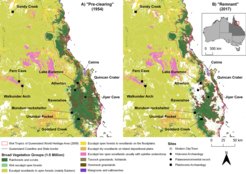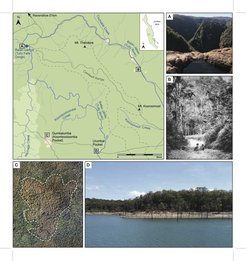Rainforests in Australia Were Shaped by Millennia of Aboriginal Land Management
Conservation approaches to rainforests in the Wet Tropics of Queensland must celebrate and protect both natural ‘Gondwanan’ heritage and the stewardship and cultural heritage of Aboriginal peoples.

The Wet Tropics of Queensland, a UNESCO World Heritage Center in Australia, is home to a unique variety of plant lineages that trace their origins to the ancient super-continent Gondwanaland, which consisted of present-day South America, Africa, Arabia, Madagascar, India, Australia and Antarctica. Although these ‘ancient’ evolutionary records are rightly prominently emphasised in current management plans, multidisciplinary research and lobbying by Rainforest Aboriginal Peoples have also persistently highlighted the significance of the cultural heritage of the Wet Tropics.
In a new paper, an international team of scientists, including those from the Department of Archaeology, Max Planck Institute for the Science of Human History, joined with Traditional Owners of Queensland’s Wet Tropics Bioregion to demonstrate the diverse ways in which these forests are globally significant, not just for their ecological and biological heritage, but also for millennia of anthropogenic activities they preserve.
Combining insights from archaeology, history, and Aboriginal oral histories, the authors show that the rainforests of this part of the world have been occupied since at least the terminal Pleistocene - if not earlier, although permanent, widespread occupation seems to only begin from around 2,500 years ago. The populations encountered at the time of European invasion were almost certainly larger than frequently-mentioned colonial census estimates.

Map of Aboriginal walking tracks and major cultural landmarks in the vicinity of Koombooloomba and Urumbal Pockets. A) View of Balan Garrya (Tully Falls Gorge); B) Photograph of Aboriginal children on a maintained walking track in the Wet Tropics. Source: Courtesy John Oxley Library, Brisbane (late 1800-early 1900s); C) Aerial image of Gumbalumba (Koombooloomba) Pocket showing the clear impact of past Aboriginal fire management still visible within modern rainforest vegetation. Source: Creative Commons Attribution 4.0 license. D) View of Urumbal Pocket 1060 from Balan Jaban (Tully River).
Aboriginal populations used a variety of forest resources. Studies of ancient plant parts and traces of wear on tools show that these communities were processing often-toxic rainforest plants from as early as 5,000 years ago. They also hunted local animals and, according to historical references, may even have captured and tamed the enigmatic cassowaries. Together, this enabled pre-colonial human populations to survive all year round in rainforest settings.
These communities not only made expert use of tropical forest plants and animals, but may also have manipulated them. Palaeoecological and oral historical evidence of controlled burns for the clearing of settlement space and forest trails clearly suggest deliberate forest management. As do the clusters of economically important fruit trees near archaeological sites. This past management has left a lasting legacy on the biodiversity and ecological dynamics of the region today.
Rainforest Aboriginal Peoples have been campaigning for inclusion in management plans since the inception of the Wet Tropics Bioregion. Although the struggle is ongoing, the Australian National Heritage List now includes cultural values and Aboriginal representation in the Wet Tropics, an important step against the suppression of traditional knowledge and management that has seen changes to the forests of the region and exposed both biological and cultural heritage to increasingly intense bushfires.
Growing administrative and financial support for Indigenous Protected Areas, ranger groups, eco-tourism initiatives, and active land management and traditional burning should be celebrated. Increasing acknowledgment of the joint natural and cultural significance of this region, so long advocated by its Traditional Owners, promises to raise awareness about the international importance of the Wet Tropics. Through extensive investigation and cooperation, researchers hope to shape and inform policies protecting the ecological, economic, and cultural resources crucial for the Wet Tropics’ Aboriginal inhabitants, as well as for the nation, and the planet, as a whole.

